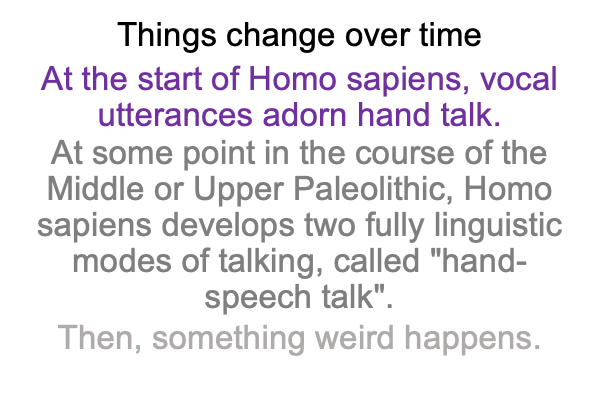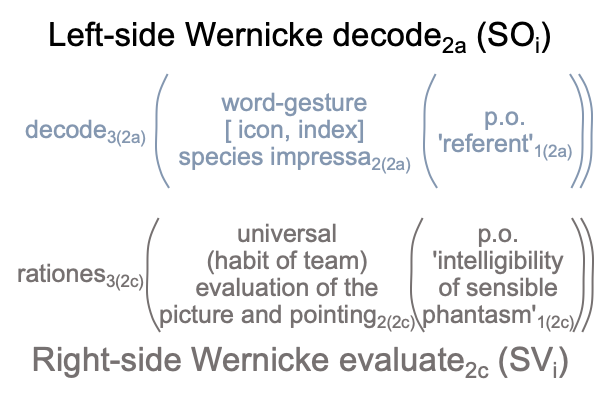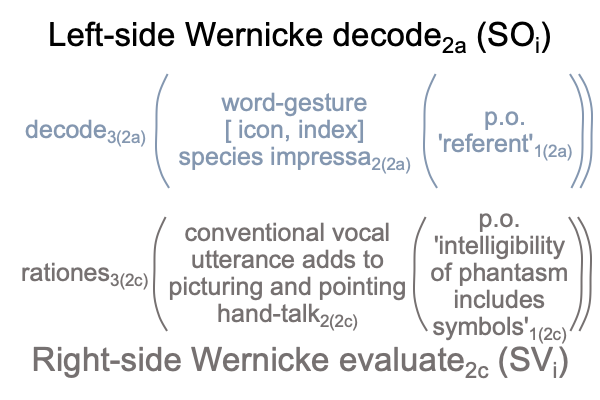0385 Things change. That is the message that underlies the word, “evolution”.
If I start with Homo sapiens decoding vocal utterances along with the hand-talk gesture-words that they adorn and if I end with civilized humans practicing speech-alone talk, then there must be a development and then a twist, as shown in the following figure.

0386 The first step coheres with the evolution of the bicameral mind as the two-chambered organ that pumps interventional sign-relations.
The Wernicke’s region on the left adapts to hand-talk. Decoding becomes more automatic with fully linguistic hand-talk. Decoding contributes to the interventional sign-object (SOi), the species impressa2a.
The Wernicke’s region on the right adapts to the niche of the perspective level of the scholastic interscope. Fully linguistic hand-talk allows grammatically correct counter-intuitive statements. Each word-gesture of these mystical statements is evaluated according to the original mission of right-side Wernicke’s region. Original mission? The right-side holistically assesses the integrity of hand-talk icons and indexes. Do hand-talk words comport with imagery, indexality, as well as team situation?
But, now the Wernicke’s region on the right offers additional value by engaging in synaesthesia, the evaluation of the accompanying vocal utterance. This evaluation assists the left-side Wernicke’s region in decoding hand-talk words during conversations and performances illuminated by fire.
0387 The first step coheres with Mithen’s nyet hypothesis.
0388 The second step consists of developments over the next two-hundred and forty thousand years.
The left-side Wernicke’s region adapts to decoding both hand-talk and vocal utterances, in tandem (as when a spoken word adorns its hand-talk gesture-word) and independently (under socially prescribed conditions). The communitygains another cultural trick to assist in maintaining social harmony among circles. This trick is used in a variety of manners.
0389 One of the tricks involves extending what vocal utterances originally do. Spoken words adorn hand-talk words. Manual-brachial word-gestures are grounded in icons and indexes. They picture and point to their referents, even when used in grammatically correct, counter-intuitive statements, such as the stories about [RABBIT][MAN] and [WOLF][MAN]. Vocal utterances cannot serve as icons and indexes. They are purely symbolic. So, spoken wordscoupled to hand-talk add a symbolic adornment.
0390 So, what is a “symbol” and what does “it” have to contribute to the evolution of adornment?
0391 According to Charles Peirce, a “symbol” is a natural sign-relation whose sign-object is determined on the basis of habit, convention, law and so forth. A symbol belongs to a symbolic order. Each symbol in a symbolic order obviously differs from all other symbols.
If I introduce Mithen’s nyet hypothesis to this picture, I imagine that synaesthesia acts like a habit. The habitconsistently chooses one vocal utterance for one hand-talk word.
0392 According to modern anthropologists, a “symbol” is a label for any manufactured artifact that does not have obvious utility. I say this tongue in cheek. For example, a laboriously fashioned stone spear-tip is not a symbol. An ibex carved into the handle of a spear-thrower is.
The implication is not straight-forward. When an evolutionary anthropologist labels an artifact as a “symbol”, that means that the scientific discipline cannot explain the artifact, because the inquirer does not know what the symbol represents. So, a symbol is an artifact that represents ‘something’, but the anthropologist cannot ascertain what that ‘something’ is.
0394 In the case of an ibex carved into the handle of a spear-thrower, the anthropologist can say that it is a symbol of an ‘ibex’. And here, the symbol represents ‘something’ about the ibex that the anthropologist cannot ascertain.
Indeed, what is the affectiveness of symbols?
I wonder, “If the carved ibex constitutes an interventional sign-object (SOi), then what is the correspondinginterventional sign-vehicle (SVi)?”
Oh! Does SVi correspond to commitment2c?
How unexpected is that?
0395 Once the inquirer grasps this idea of what a symbol is, then “adornment “is the appearance of an interventional sign-object (SOi) that symbolizes ‘something that must be present but cannot be seen’, that is, an interventional sign-vehicle (SVi).
0394 Ah, is this why hand-speech talk and adornment may be linked in their evolutionary development?
Both speech and adornment contribute a symbolic ‘something’ to a visual species impressa2a.
0395 If I take the liberty to depict “decoding2a” as the operation of a category-based nested form, performed by Wernicke’s region on the left of the brain, then a right-side mirror image appears in commitment2c.

0396 The actuality2c on the bottom corresponds to SVi. The actuality2a at the top corresponds to SOi.
The evaluation2c on the right-side offers a SVi that produces, by the left-side, an SOi, that is a sensible species impressa2a.
0397 The importation of hand-talk into communal settings with the domestication of fire introduces social construction. After a few hundred-thousand years, the voice slowly gets added to hand-talk. Once hand-speech talkemerges as an adaptation, with the appearance of our own species, Homo sapiens, vocal utterances adorn manual-brachial word-gestures to such an extent that their symbolic aspects become more and more integrated into hominin phantasms2b, contributing to a new style of intelligibility2c.
0398 Here is a picture of that new style.

0399 Replace the picture and pointing of the hand-talk word2(2c) with the physicality and the imagery of a Paleolithic artifact2(2c), then the artifact2(2a) speaks for itself.
How?
Am I back to Jaynes’s awkward term, “auditory hallucinations”?
